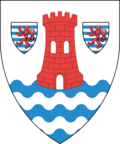History
Like the other cantons of Luxembourg, the canton of Esch dates back to 31 August 1795. However, it was created under the name of the canton of Soleuvre. This term was of short duration since, already on 22 October 1796, a new decree renamed it the canton of Bascharage. Bascharage canton was less spread-out than the current canton of Esch since Leudelange, Pontpierre, Bettembourg and Dudelange belonged to the canton of Hesperange, created to the south of the capital. Bascharage canton, on the other hand, included Marner, which is now in Capellen canton. Subsequently, there was a new disruption of the cantonal borders, which were at the same time administrative and judicial divisions, after a consular decree of 6 March 1802. The number of cantons in the Forêts department was reduced from 37 to 27 and, in the place of Bascharage canton, a canton of Bettembourg was created. However, this did not have the same borders as its predecessor, as it lost its western part, which went to the neighbouring canton of Messancy. The boundary between the cantons of Bettembourg and Messancy passes between Differdange (in the canton of Messancy), and Belvaux (in the canton of Bettembourg). Twelve years later came the end of Napoleon's Empire, the end of the Forêts department, and Luxembourg's de facto incorporation into the Kingdom of the Netherlands. The Dutch administration maintained the French administrative divisions, except for renaming arrondissements to districts. [1]
After the Belgian Revolution of 1830, this system ended and for nine years, the administration of the Grand-Duchy — before its third partition — was carried out by Belgium, except for the city and federal fortress of Luxembourg, with its Prussian garrison. Under the French and Dutch administration, there had been a district of Luxembourg, whose commissioner naturally resided in Luxembourg City. In order to administer this district, apart from Luxembourg City itself, the seat of the commissioner, an agent of the Belgian government, had been transferred to Bettembourg. This village of 740 habitants was now the administrative centre of the district. The notary Philippe Hanno, a Luxembourg native, was named district commissioner with residence in Bettembourg. In the night of 15 February 1834, the Prussian general du Moulin, commandant of the Fortress of Luxembourg, had Hanno captured in Bettembourg and imprisoned in Luxembourg. It required the intervention of France and the United Kingdom before Hanno was released. [1]
The Treaty of London of 1839 divided Luxembourg, and in doing so, also partitioned the border cantons, from Troisvierges to Pétange.
The neighbour of the canton of Esch was that of Messancy, whose territory mostly passed to Belgium. The rest, that is the communes of Pétange and Differdange, was added to the canton of Bettembourg. At the same time, however, Bettembourg canton lost the commune of Dippach to the canton of Capellen, and the commune of Weiler-la-Tour to Luxembourg canton. With 13,116 inhabitants, the canton of Bettembourg was second to that of Luxembourg, with 27,891 inhabitants. Bettembourg was an agricultural canton. Minette ore was still unknown. Alluvial ore was scraped and washed in Bascharage, Pétange, Differdange, Esch, Kayl and Bettembourg. In terms of factories, there was only the blast furnace of Lasauvage. There were no cities. Esch, which would later become a city, had at this time only 1,400 inhabitants. In Esch, there were two tanneries. [1]
After an administrative reorganisation, necessitated by the partition, a decree of 12 October 1842 transferred the justice of the peace, and therefore the administrative centre of the canton, from Bettembourg to Esch. The reason was that, due to the additions to the west and the territorial losses in the east mentioned above, the canton's centre had moved to the west, and now, more than ever, Bettembourg was on the periphery. [1]
However, the question of its administrative centre came up again when, in 1849, the Chamber of Deputies, considered a bill to re-establish the justice of the peace in Bettembourg, and therefore the canton's centre. The originator of this bill was the notary Graas, from Bettembourg. Four communes of the canton supported it, while seven opposed it. The government was also against it, and the bill failed. [1]
In 1860, the mayors of Clemency, Dippach, Bascharage, Pétange, Sanem and Differdange addressed a petition to the Assembly of Estates, demanding that due to their great distance from the canton's centre Esch, they should be carved off and organised into their own new canton of Bascharage. The petition was not taken into consideration by the Assembly. [1]
Since then, the canton of Esch has seen several internal changes.
Since 1847, the inhabitants of Leudelange had not ceased to demand their separation from the commune of Reckange, and to be organised into a distinct commune. As justification they invoked Reckange's distance of more than 6 km, the fact that Leudelange was already a parish and that, until 1821, there had been a commune of Leudelange. At the session of the Estates of 15 February 1856, this was approved by 33 votes to 3. Then, in 1862, in a petition to the Estates, the commune of Leudelange demanded to be detached from the canton of Esch to be added to that of Luxembourg. [1]


